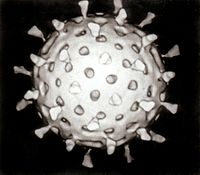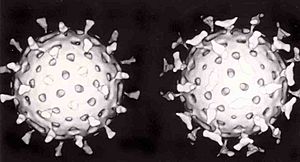Virus facts for kids
Quick facts for kids Viruses |
|
|---|---|
 |
|
| Rotavirus | |
 |
|
| A diagram of an envelope virus | |
| Virus classification | |
| Group: |
I–VII
|
| Groups | |
|
I: dsDNA viruses |
|
A virus is a super tiny parasite that can infect living organisms. It can make you sick! Viruses are so small you need a special electron microscope to see them. They are much smaller than bacteria.
Viruses can't live or make copies of themselves alone. Instead, they sneak into another organism's cells. Once inside, they take over the cell's machinery to make many copies of themselves. After that, the cell often bursts, releasing new viruses to infect more cells. This is how all viruses reproduce.
A virus has a simple structure. It's mostly made of nucleic acid (like RNA or DNA) and a protein coat around it. Viruses don't have their own internal cell parts, like a cell wall or cell membrane. Because they live inside your cells, regular medicines like antibiotics don't work against them. Antibiotics are for bacteria, not viruses.
Viruses cause many diseases. Some examples are polio, ebola, and hepatitis. The study of viruses is called Virology.
Viruses have these key features:
- They are tiny particles that cause many diseases.
- They have a core of RNA or DNA.
- This core is protected by a protein coat.
When a virus infects an animal cell, its protein coat helps it attach to the cell's surface. For bacteria, special viruses called bacteriophages inject their genetic material right into the cell. Once the host cell has made new viruses, it often breaks open, releasing the new viruses to infect other cells. Viruses can stay active for a long time, waiting for the right conditions to infect.
Some viruses are special. Bacteriophages are viruses that infect only bacteria. Envelope viruses are tricky. When they reproduce, they wrap themselves in a piece of the host cell's outer membrane. This extra layer helps them get into new cells. Viruses like influenza and HIV use this method, making them hard to fight.
When animals get a viral infection, their immune system usually fights it off. Vaccines can also help. They teach your immune system how to fight a specific virus before you get sick. But some viruses, like those causing AIDS and hepatitis, can hide from the immune system and cause long-term infections.
Contents
What is a Virus Genome?
Every living thing has a genome, which is like its instruction manual. Viruses also have genomes, but they are very diverse. Viruses have more different types of genomes than plants, animals, or bacteria! There are millions of different viruses, but scientists have only studied about 5,000 in detail.
A virus's genome is made of either RNA or DNA. So, we call them RNA viruses or DNA viruses. Most viruses have RNA genomes. For example, plant viruses often have single-stranded RNA, while viruses that infect bacteria (bacteriophages) usually have double-stranded DNA.
How Viruses Reproduce
Viruses don't grow by dividing like cells do. Instead, they use a host cell's parts and energy to make many copies of themselves. Then, these new virus parts come together, or assemble, inside the cell.
The way viruses reproduce, or their life cycle, can be different for each type. But there are six main steps:
- Attachment: The virus first sticks to a specific spot on the host cell's surface. It's like a key fitting into a lock.
- Penetration: After attaching, the virus gets inside the host cell. Animal viruses can enter by being swallowed by the cell or by merging with the cell's outer layer. Plant and fungus cells have strong cell walls, so viruses often need help to get in, like from an insect that bites the plant. Bacteria also have cell walls, but some viruses can inject their genetic material right through them.
- Uncoating: Once inside, the virus sheds its protein coat. This releases its genetic material (nucleic acid) into the cell.
- Replication: The virus's genetic material takes over the cell. It forces the cell to make many copies of the virus's genes and proteins.
- Assembly: All the newly made virus parts come together to form new, complete virus particles.
- Release: Finally, the new viruses leave the host cell. Some viruses burst the cell open, killing it. Others, especially those with an outer "envelope," bud off from the cell, taking a piece of the cell's membrane with them.
Genetic Material and Replication
The genetic material inside viruses, and how they copy it, varies a lot.
- RNA viruses
- These viruses usually copy their genetic material in the cell's cytoplasm. They use their own special enzymes, called RNA replicase, to make copies of their RNA genomes.
- DNA viruses
- Most DNA viruses copy their genetic material in the cell's nucleus. They often use the host cell's own machinery to do this.
- Reverse transcribing viruses
- These viruses are unique. If they have an RNA genome (like HIV), they first turn their RNA into DNA using an enzyme called reverse transcriptase. If they have a DNA genome (like Hepatitis B virus), they use an RNA step to copy their DNA. Medicines that block reverse transcriptase can fight these viruses.
How Your Body Fights Viruses
Your body has amazing ways to protect itself from viruses.
Innate Immune System
Your body's first line of defense is the innate immune system. This system has cells and other tools that fight any infection in a general way.
One important defense is called RNA interference. Many viruses make double-stranded RNA (dsRNA) when they copy themselves. When your cell finds this dsRNA, a protein called dicer chops it into pieces. Then, another system attacks the virus's genetic messages, helping the cell survive.

Some viruses, like rotaviruses, are clever. They keep their dsRNA hidden inside their core, so your body's defenses can't easily find it.
Your body also produces a hormone called interferon. Interferon helps stop viruses from reproducing by telling infected cells and their neighbors to stop the virus.
Adaptive Immune System
Vertebrates (animals with backbones, like humans) have a second, more specific immune system called the adaptive immune system. When it meets a virus, it makes special antibodies. Antibodies are like tiny shields that stick to the virus and stop it from infecting cells.
There are two main types of antibodies:
- IgM: These antibodies are very good at stopping viruses, but your body only makes them for a few weeks after an infection.
- IgG: These antibodies are made for a very long time, sometimes forever. If you have IgG antibodies, it means you were infected with that virus in the past or got a vaccine for it.
Another way your adaptive immune system fights viruses is through cell-mediated immunity. This involves special immune cells called T cells. Your body's cells constantly show tiny pieces of their proteins on their surface. If a T cell sees a piece that looks like it's from a virus, special "killer T" cells destroy the infected host cell.
How Viruses Hide from Your Immune System
Not all virus infections lead to full protection. Some viruses are very good at hiding from your immune system. They might:
- Hide in places your immune system can't reach, like along nerves.
- Block your cells from showing viral pieces to T cells.
- Change their surface proteins constantly, like HIV does, so the immune system can't recognize them.
Virus Evolution
Viruses are a bit mysterious when it comes to classifying them as living things. They don't do much until they infect a cell. However, they definitely have evolved from other living things. Some scientists think viruses might have come from plasmids (small pieces of DNA that can move between cells) or even from tiny bacteria.
Viruses are important in evolution because they can move genetic material between different organisms. This is called horizontal gene transfer, and it helps create more genetic diversity.
Recent Discoveries About Viruses
Scientists are always finding new things about viruses. A recent project found almost 1500 new RNA viruses by studying over 200 different invertebrate species (animals without backbones, like insects). Researchers looked at the RNA from these animals and found many new virus genetic codes. This research showed that viruses are very flexible. They can swap bits of their RNA, move genes between viruses and hosts, and rearrange their genetic material in complex ways.
Largest Viruses
Some viruses are surprisingly large! A group of big viruses infects amoebae (tiny single-celled organisms). The biggest known virus is called Pithovirus. Others include Pandoravirus, Megavirus, and Mimivirus. These viruses are so big that they are larger than some bacteria and can even be seen with a regular light microscope.
How Viruses Are Used
Even though viruses cause diseases, they can also be useful!
- In cell biology, scientists use viruses as "delivery trucks" to put new genes into cells they are studying. This helps them make cells produce certain substances or learn how new genes affect cells.
- In some places, like Eastern Europe, scientists use phage therapy. This means using bacteriophages (viruses that infect bacteria) to fight bacterial infections. This is becoming more interesting as some bacteria become resistant to antibiotics.
Related pages
Images for kids
-
Martinus Beijerinck in his laboratory in 1921
-
Transmission electron microscope image of a recreated 1918 influenza virus
-
Peppers infected by mild mottle virus
-
Scientist studying the H5N1 influenza virus
See also
 In Spanish: Virus para niños
In Spanish: Virus para niños









